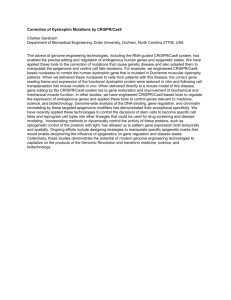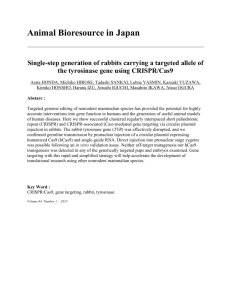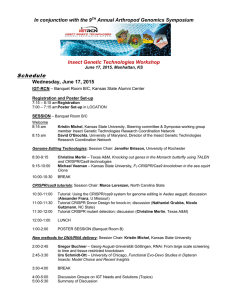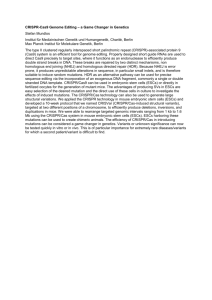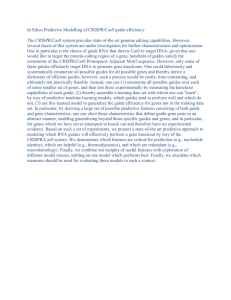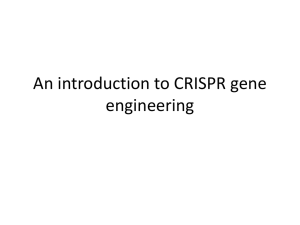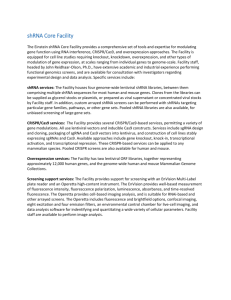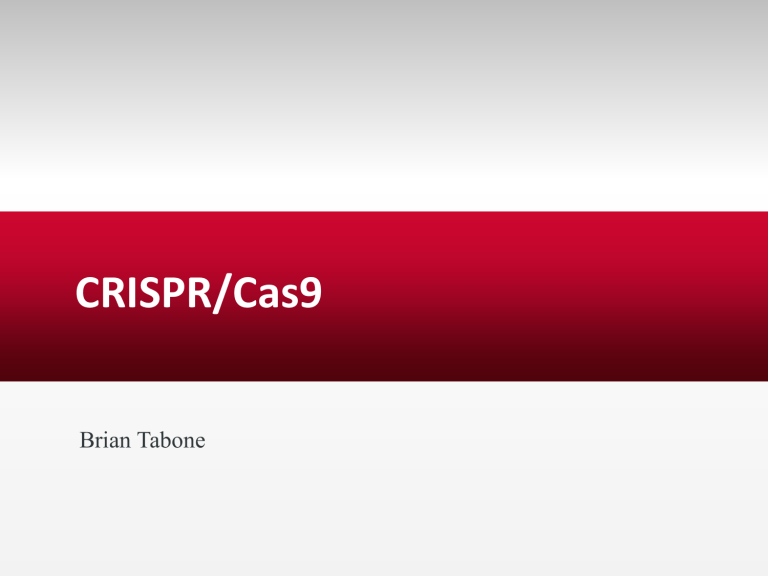
CRISPR/Cas9 Brian Tabone What is CRISPR/Cas9? • The CRISPR/CAS9 system is comprised of clustered regularlyinterspersed short palindromic repeated (CRISPR) DNA sequences and CRISPR-associated genes (Cas) which code for proteins which can read these sequences and locate them in other DNA strands and perform operations on them (such as cut out or split and inject new sequences). • The CRISPR/Cas system evolved in nature as an immune defense mechanism against viruses which attack bacteria. In nature, the system warehouses DNA snippets from previous invaders and uses this library to quickly identify and neutralize invading virus DNA when it is next encountered. • CRISPR/Cas9 has been adapted by science for precise, repeatable, low cost gene editing that works in a multitude of species including in humans. CRISPR/Cas Immune Function CRISPR/Cas9 history • Scientists discovered the CRISPR/CAS system in the early 80s when studying strains of the E. coli bacteria, but where not certain of its function. • The immune function of this system was confirmed in 2007 by R. Barrangou and colleagues during their studies of immune response to bacteriophage viruses attacking S. thermophilus bacteria (a bacteria common in yogurt). • In 2012, Doudna and Charpentier labs discovered the potential for reliable, easy gene editing through application of the CRISPR/Cas9 version of the CRISPR/Cas system What makes CRISPR/Cas9 valuable • Previous gene editing techniques such as Zinc-finger nuclease enhanced gene targeting and TALENs are more costly, difficult, and error prone. • New England BioLabs reports: “in human cells, custom-designed ZFNs and TALENs could only achieve efficiencies ranging from 1% to 50%. In contrast, the Cas9 system has been reported to have efficiencies up to >70% in zebrafish and plants, and ranging from 2– 5% in induced pluripotent stem cells.” • They type II CRISPR nuclease simplicity and the requirements of only 3 components (Cas9, crRNA and trRNA) make this system easy to adapt for gene editing. • CRISPR/Cas9 promises to lower the cost, improve accuracy, and increase availability of genetic engineering to a broader spectrum of scientists and engineers CRISPR/Cas9 Gene Editing • Previous gene editing techniques such as Zinc-finger nuclease enhanced gene targeting and TALENs are more costly, difficult, and error prone. • New England BioLabs reports: “in human cells, custom-designed ZFNs and TALENs could only achieve efficiencies ranging from 1% to 50%. In contrast, the Cas9 system has been reported to have efficiencies up to >70% in zebrafish and plants, and ranging from 2– 5% in induced pluripotent stem cells.” • They type II CRISPR nuclease simplicity and the requirements of only 3 components (Cas9, crRNA and trRNA) make this system easy to adapt for gene editing. • CRISPR/Cas9 promises to lower the cost, improve accuracy, and increase availability of genetic engineering to a broader spectrum of scientists and engineers What can we do with CRISPR/Cas9 • Control gene expression by activating or repressing target sequences • Identify sequence locations in a genome using fluorescent molecules on nondestructive Cas9 enzymes • Treat Cystic Fibrosis by inserting the missing gene sequence. Correct the missing sequence so that is not passed down through subsequent generations. • Edit the gene sequence of mosquitos to either reduce their reproduction rate or reduce their ability to carry diseases like Malaria. • Rapidly develop transgenic models which expands biological research beyond traditional animal model organisms. Risks • CRISPR/Cas9 may make it easier for bad actors to create weaponized diseases. • A black market for gene editing of babies may become possible due to the low cost and ready availability of the technology coupled with the desire for improved competitiveness of one's children. • Make it easier for corporations to make genetically modified organisms for commercial use, with all the unintended consequences that implies. References • • • • • • Genome Editing Overview New England BioLabs Cell.com YouTube video on Gene Editing with CRISPR/Cas9 CRISPR's Most Exciting Uses Have Nothing to Do With Gene-Editing Scientists Call for Caution in Use of CRISPR/Cas9 Technology
